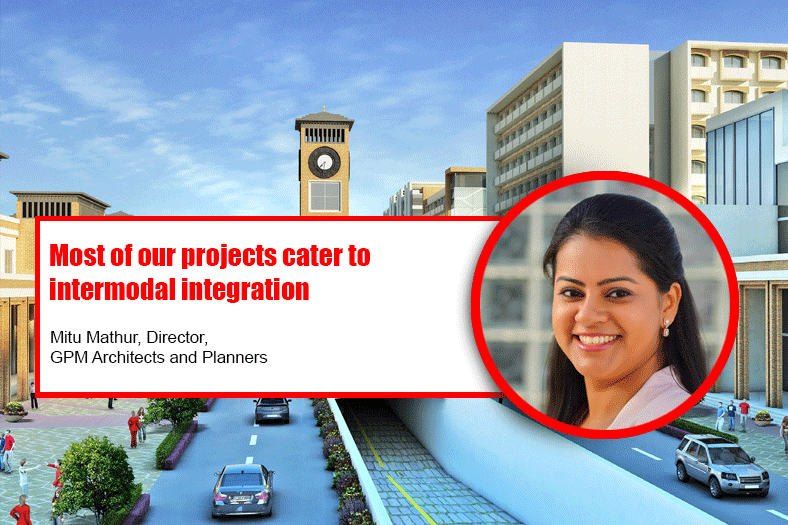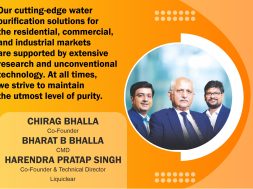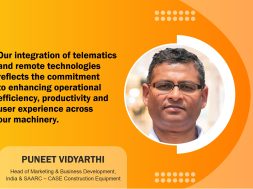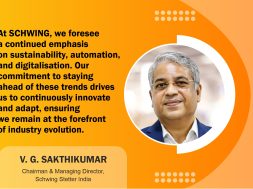Most of our projects cater to intermodal integration

By connecting railways, bus stations and metros car travels can be reduced, it thereby improves the mobility pattern of the city and in a way reduces pollution too says Mitu Mathur, Director, GPM Architects and Planners.
What is the scope of work involved for GPM as far as the railway and the metro projects are concerned?
Railway station development projects involve preparation of the RFQ document, which is floated for PPP development. Once the RFQ is floated, then the project is awarded and an architect is appointed. We form a consortium with all experts, planners and authorities to provide the Master plan, pursue initial studies, reiki for projects, procure all required data from railway zonal and DRM offices. Once the data is collected and analyzed, we initiate surveys such as station surveys, drone surveys, traffic surveys, footfall surveys, train arrival and departure timings. The surveys alone take around 2-3 months. Once the surveys are completed, it takes another 3 months for approvals. Only after this stage is the master plan finalized.
There are two integral components to the development- Mandatory works that pertain to railway station development and stage 1 of the master plan completion. This phase works on the station enhancement facilities and networks, inclusive of heritage development. The developer comes into play to finish this phase before starting any marketing exercise. The next component is the real estate aspect, where the developer is on the profit earning end.
Unlike railways, the scope for metro station projects we are involved is focussed on designing stations and its successful integration with the local context. It also includes detailed engineering and practical feasibility study.
What kind of collaboration is involved in such projects, who are the people you collaborate with?
The role of an urban planner and architect is critical in such development projects. As consultants, we also collaborate with transport planners, financial and real estate experts, heritage experts, landscape and environment experts, and engineers. Once the required data is in hands and processed, and the master plan development options are prepared, it is parallelly discussed with the zonal railway departments, DRM offices and the Indian Railway Stations Development Corporation.
Can you tell us something about the projects completed so far?
All of our railway development projects are still on-going. Some of the future projects we are working on are- Tirupati station, Ludhiana station, Nellore station, Dehradun station, Adarsh Nagar station, and Guntakal station. Any railway station redevelopment project has three aspects- Facilities enhancement and Augmentation which includes waiting rooms, lockers, retail stores and food & beverage kiosks, depending on the average footfall. The next aspect is Traffic movement- which includes segregating arrival and departure traffic by means of city planning. It is critical to integrate the station within the city, in context with the larger master plan, similar to airport arrival and departure gates. On the local level within stations, it is critical to integrate how people get off trains and go to different arrival and departure concourse.
It is of utmost important to unlock the real estate potential of such projects for the city, in order for any developer to take interest and invest. Railway station development projects sit in the heart of the city and thus have good land value to be developed. They also hold great control to stitch the city fabric into one, seamlessly integrating the two sides of the city.
What are some of the core challenges your firm had to address on-site?
In railway projects one of the core challenges is to gather data. A railway station is not a simple entity, hence collecting data from various zonal offices, authorities and departments get tedious. Another challenge faced with such projects is getting approvals, as this task is extensively time-consuming.
In metro projects the challenges centre around engineering. The challenges are usually to do with the clearances and planning, rather than execution. A lot of services requires synchronised co-ordination which necessitates collaboration of various teams and service providers. Precision in laying all services efficiently is of utmost importance. Vibrations from movements need to be addressed. Construction of underground tunnels is a tedious task and requires in-depth study of the stretch. Choice of materials is also crucial and is often derived by its maintenance properties. Since the metro stations cater to a large footfall, easy maintenance is a crucial factor in choosing the right materials. Also, load bearing capacity and installation determines the choice of material.
What strategies do you have in place to ensure reliability, sustainability, and energy efficiency in this project?
Sustainability is an important factor in our development projects as railway travels are still not at the forefront of the country, and these projects address the need of the hour. Our country has the largest railway networks and the largest land bags, which makes railways the backbone of our country. There is a critical need to revitalize the inter-city commute issues, to reduce dependence on metropolitan cities, which in turn will lead to a decrease in migration. Railway development projects hold unprecedented potential with sustainability. Our development projects follow efficiency by adhering to all pertaining guidelines and laws. By developing under-utilized pockets of the city, we also efficiently look at denser developments and connections. Most of our projects cater to intermodal integration by connecting with bus stations and metros. This, in turn, reduces the impact on car travels and improves the mobility pattern of the city and in a way reduces pollution too.
Unlike your railway projects which are currently ongoing, you have already designed numerous metro stations, what is your thought on the end design?
Projects of this nature involves a lot of hard work and coordination between different teams, starting right from the raising of RFQs to completion. I think the project is successful as long as it serves the users efficiently and sustains itself with minimum maintenance.
We have designed a few metro stations for DMRC in the last decade. All of those are fully functional and serving the purpose well. Azadpur Metro station is currently under construction and is likely to be completed in 2021.
How had the COVID-19 pandemic impacted the project and how are you addressing it?
The COVID-19 pandemic will have a significant impact on all development projects as traveling from trains will change, as all railway projects are dependent on footfall. If there will be lesser people traveling by trains, the user needs and station designs will change coherently. There will be a reduction in such project tenders which is dependent on railways, and hence private developers will be hesitant in putting their money. In this case, there might be a need to break down the project into phases.
7
Cookie Consent
We use cookies to personalize your experience. By continuing to visit this website you agree to our Terms & Conditions, Privacy Policy and Cookie Policy.









